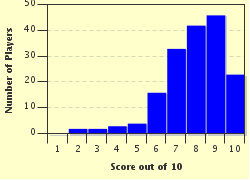Quiz Answer Key and Fun Facts
1. Who went to the pantry to get her favorite pet a treat, only to find the shelves empty?
2. Which important person is the host of the cat who likes to chase mice under chairs?
3. What yummy fruit did little Jack find in his Christmas pie?
4. Which child was frightened by an eight-legged bug in the process of eating her lumps of cottage cheese?
5. What two dozen singing birds get baked in a pie in a very famous nursery rhyme?
6. What treat was Simple Simon trying to obtain from a street-seller on his way to the fair?
7. In the nursery rhyme about Jack Sprat which household pet got fed the bones?
8. According to the nursery rhyme, which type of pudding is good hot, cold, or nine days old?
9. In the nursery rhyme where "Polly puts the kettle on," who takes it off again?
10. Which large vegetable (which is technically a fruit!) was a favorite of Peter and a house for his wife?
Source: Author
coachpauly
This quiz was reviewed by FunTrivia editor
looney_tunes before going online.
Any errors found in FunTrivia content are routinely corrected through our feedback system.

